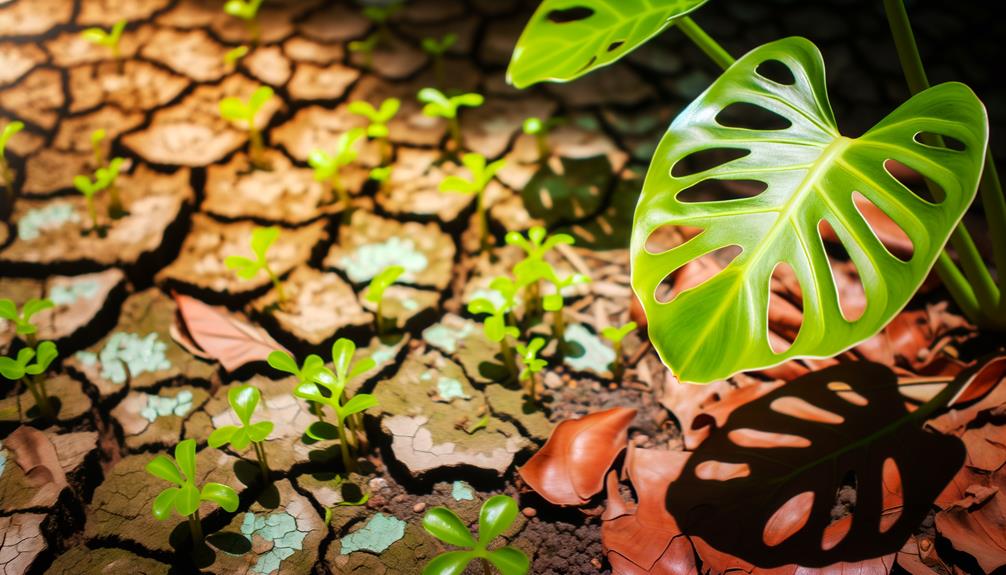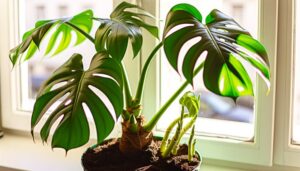Monstera Obliqua Leaves Growing in Broken: A Guide!
You’re likely noticing Monstera Obliqua leaves growing in broken due to their delicate nature and susceptibility to physical damage. Inspect your plant for tears, punctures, or irregularities, carefully noting deviations from the typical 10-25 cm long and 3-10 cm wide leaf structure.
High-traffic areas and mishandling can cause such damage. Ensure an ideal environment with temperatures between 18-27°C and humidity levels of 60-80%.
Regularly monitor for pests like spider mites and aphids using a 10x magnification lens. Proper watering, maintaining consistent soil moisture, and using well-draining soil can mitigate damage.
Stay tuned to uncover thorough care techniques.

Key Takeaways
- Inspect for physical damage from mishandling or accidental bumps causing tears or punctures in the leaves.
- Ensure consistent temperature (18-27°C) and humidity (60-80%) to prevent environmental stress and irregular growth.
- Use well-draining soil mix and water when the top 1-2 inches of soil are dry to avoid root rot.
- Monitor for common pests like spider mites and aphids; early detection and intervention are crucial.
- Provide 6-8 hours of indirect, bright light daily to support healthy leaf growth and prevent breakage.
Here’s a table chart and SEO-optimized title and meta description for “Monstera Obliqua Leaves Growing in Broken.
Monstera Obliqua Growth Stages | Leaf Size & Time
| Growth Stage | Leaf Size (cm) | Number of Leaves | Time Taken (Weeks) |
|---|---|---|---|
| Early Growth | 1 – 2 cm | 1 – 3 | 1 – 2 |
| Intermediate Stage | 3 – 5 cm | 4 – 6 | 3 – 5 |
| Advanced Growth | 6 – 8 cm | 7 – 9 | 6 – 8 |
| Mature Stage | 9+ cm | 10+ | 9+ |
Common Causes of Broken Leaves
One of the most common causes of broken Monstera obliqua leaves is physical damage from mishandling or accidental bumps. When you move the plant, make sure you handle it with care, as its leaves are delicate and can tear easily.
Each leaf measures approximately 10-25 cm in length and 3-10 cm in width, making them prone to damage if not treated gently. Even brushing against them too hard can cause structural harm.
Additionally, placing the plant in high-traffic areas increases the risk of accidental contact, leading to tears or breakage. For best health, position your Monstera obliqua in a low-traffic zone and handle it with gentle, intentional movements to minimize the risk of damage.
Identifying Physical Damage
To identify physical damage on Monstera obliqua leaves, carefully inspect for tears, punctures, or irregularities in the leaf structure, noting any deviations from their typical elongated, perforated appearance. Measure the length and width of the tears, and document the position of punctures using a ruler. Note if the damage appears symmetrical or random, as this can indicate the type of physical trauma sustained.
| Observation | Measurement/Detail | Emotional Impact |
|---|---|---|
| Tear Length | 2-5 cm | Alarming |
| Puncture Diameter | 0.1-0.3 cm | Concerning |
| Irregularities | Asymmetrical patterns | Distressing |
Environmental Stress Factors
You’ll notice that temperature fluctuations greatly impact Monstera obliqua, with best growth occurring between 18-27°C.
Consistently high humidity levels, ideally between 60-80%, are essential for maintaining leaf integrity.
If the plant experiences stress from inconsistent environmental conditions, you’ll see irregular growth and increased vulnerability to physical damage.
Temperature Fluctuations Impact
When temperatures fluctuate beyond the ideal range of 65-80°F, Monstera Obliqua leaves exhibit signs of stress, such as wilting and browning edges.
You’ll notice that rapid temperature changes cause cellular damage, disrupting the plant’s physiological processes.
High temperatures above 85°F can induce heat stress, leading to chlorosis and necrosis.
Conversely, temperatures dropping below 60°F may slow metabolic rates, resulting in stunted growth and leaf drop.
To mitigate these effects, monitor ambient temperatures using a precise digital thermometer. Ensure your Monstera Obliqua is situated away from direct heat sources like radiators or cold drafts from windows.
Maintaining stable temperatures within the specified range is essential for optimal health and growth of your Monstera Obliqua.
Humidity Levels Importance
Maintaining humidity levels between 60-80% is essential for Monstera Obliqua, as insufficient humidity can lead to leaf dehydration, curling, and increased susceptibility to pests. You should monitor the relative humidity using a hygrometer.
If levels fall below 60%, employ a humidifier or pebble tray to increase moisture. Observations indicate consistent humidity within this range promotes ideal foliar expansion and structural integrity. Low humidity often results in brown leaf edges and stunted growth.
Additionally, high humidity mitigates transpiration stress, enhancing cellular hydration. Remember, fluctuations beyond this threshold compromise the plant’s physiological processes. Make adjustments promptly to maintain equilibrium, ensuring your Monstera Obliqua thrives, demonstrating robust, fenestrated leaves indicative of excellent health.
Pest and Disease Impacts
You’ll often encounter common pests like spider mites and aphids, which can rapidly infest Monstera Obliqua leaves.
Observe for disease symptoms such as chlorotic spots or necrotic lesions, which typically indicate bacterial or fungal infections.
Regularly inspect the plant using a 10x magnification lens to detect early signs of infestation or disease.
Common Pests Infestation
Identifying common pests such as spider mites and aphids is essential for preventing your Monstera obliqua leaves from becoming damaged and diseased.
Spider mites, typically less than 1 mm in size, create fine webbing on leaf surfaces. Aphids, measuring around 2-4 mm, cluster on the undersides of leaves, secreting a sticky substance called honeydew. Monitor your plant closely; use a magnifying glass to detect these minuscule invaders.
Early signs include yellowing leaves, stippling, or a general decline in plant vigor. Regularly inspect for black sooty mold, which thrives on aphid honeydew. Employing neem oil or insecticidal soap can eradicate these pests effectively.
Prompt intervention will maintain your Monstera obliqua’s health and prevent further infestations.
Disease Symptoms Identification
Recognizing the disease symptoms on your Monstera obliqua is crucial for timely intervention and involves observing specific changes like leaf discoloration, unusual spots, and structural deformations.
Look closely for chlorosis, where leaves turn yellow due to chlorophyll degradation. Notice any necrotic spots, often brown or black, indicating tissue death. Monitor for powdery mildew, appearing as white, powder-like patches. Inspect the leaf structure for distortions or curling, as these can signal viral infections.
Measure leaf size discrepancies, as stunted growth could indicate root rot or nutrient deficiencies. Keep an eye on the leaf surface for sticky residues, a sign of pest-related diseases like sooty mold.
Early detection guarantees you can address issues before they compromise plant health.
Proper Watering Techniques
Proper watering techniques for Monstera obliqua involve maintaining a consistent moisture level, making sure the soil is kept damp but not waterlogged, and using a well-draining potting mix to prevent root rot. You should water your Monstera obliqua when the top 1-2 inches of soil feel dry.
Use a soil moisture meter for precise measurement, aiming for a reading between 3 and 4 on a scale of 1 to 10. Additionally, verify your pot has drainage holes to facilitate proper water flow and avoid water accumulation at the base.
Over-watering can lead to root suffocation, while under-watering may cause leaf deformities. By keeping these factors in check, you’ll promote healthy growth and vibrant leaves in your Monstera obliqua.
Nutrient Deficiencies
Diagnosing nutrient deficiencies in Monstera obliqua involves observing specific symptoms such as yellowing leaves, stunted growth, or brown leaf edges, which indicate imbalances in essential nutrients like nitrogen, phosphorus, and potassium.
Yellowing leaves, especially older ones, suggest a nitrogen deficiency. Phosphorus deficiency manifests as stunted growth and dark, purplish leaf veins. Brown leaf edges often signal potassium deficiency.
Use a soil pH meter to optimize nutrient availability; Monstera obliqua thrives at a pH of 5.5 to 7.0. Apply balanced, water-soluble fertilizers with an N-P-K ratio of 20-20-20 to correct these imbalances.
Regularly monitor leaf color, size, and overall plant vigor to accurately and efficiently meet the plant’s nutrient needs.
Supporting Healthy Growth
To support healthy growth in Monstera obliqua, make sure the plant receives indirect, bright light for at least 6-8 hours daily and is maintained in a humidity range of 60-80%. Consistent watering is essential; confirm the soil is moist but not waterlogged. Use a well-draining potting mix comprising peat, perlite, and orchid bark in a 2:1:1 ratio. Fertilize monthly with a balanced, water-soluble fertilizer during the growing season.
| Aspect | Recommendation |
|---|---|
| Light | Indirect, bright light for 6-8 hours daily |
| Humidity | Maintain 60-80% humidity |
| Soil Mix | Peat, perlite, orchid bark (2:1:1 ratio) |
Monitor for pests like spider mites and scale insects, and prune dead or damaged leaves to promote new growth.
Preventative Care Tips
Regularly examine your Monstera obliqua for signs of pests or diseases to ensure early detection and treatment. Make sure you’re providing an ideal environment with precise care.
Here’s a list of critical preventative measures:
- Humidity: Maintain a consistent humidity level of 60-80% to deter leaf desiccation.
- Light: Place your plant in indirect, bright light, avoiding direct sun exposure.
- Watering: Water when the top 1-2 inches of soil are dry; excessive watering can result in root rot.
- Soil: Utilize a well-draining soil mix with high organic matter content.
- Cleaning: Clean leaves with a damp cloth to eliminate dust and discourage pests.
Conclusion
You’ve now become a plant detective, armed with the knowledge to rescue your Monstera obliqua from the brink of leafy disaster. Whether it’s the relentless sun scorching the delicate foliage, or rogue pests turning leaves into a battlefield, your vigilant care can restore their verdant splendor.
By mastering precise watering techniques and ensuring balanced nutrients, you’ll transform those tattered leaves into a lush, thriving canopy that would make even a rainforest jealous. Embrace your green thumb and conquer!






